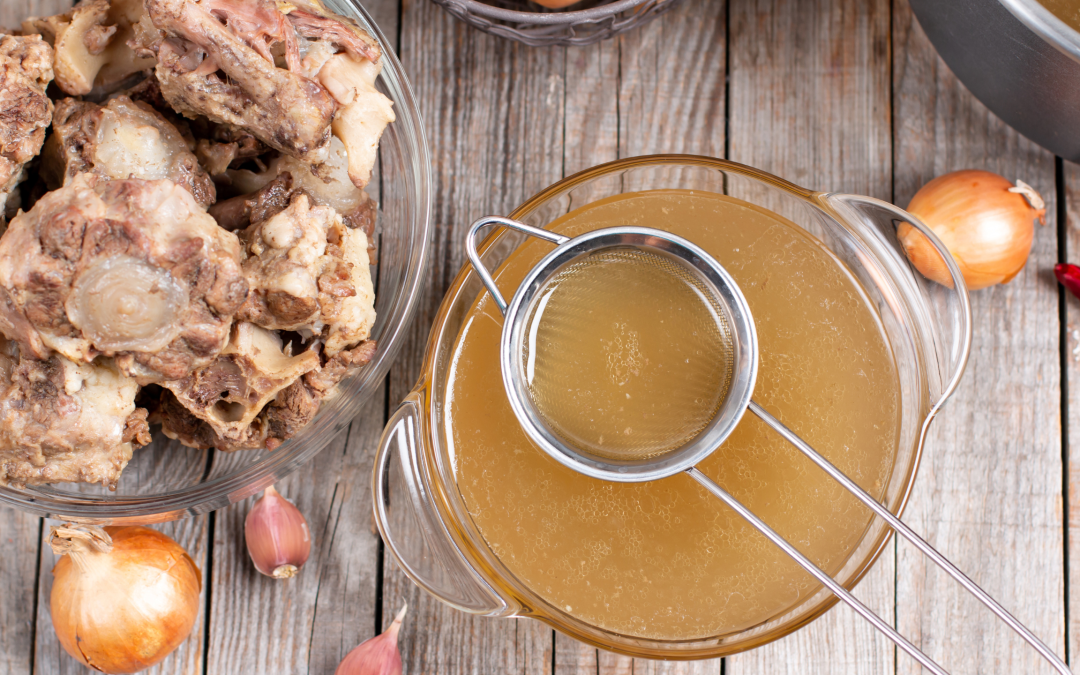Have you ever found yourself wandering down the soup aisle or scrolling through recipes, wondering what exactly is the difference between bone broth and stock? You’re not alone! These two kitchen staples are often used interchangeably, but they have distinct differences that can affect the flavor and nutrition of your dishes. Explore the bone broth and stock world to uncover what sets them apart.
Understanding Bone Broth and Stock
First things first, let’s define what each one is.
What is Stock?
Stock is a savory liquid made by simmering animal bones (often roasted for added flavor), meat scraps, and vegetables like onions, carrots, celery, and herbs in water for several hours, typically 2 to 4 hours. The purpose of stock is to extract flavors that will serve as a foundation for soups, sauces, and other dishes. It’s rich in flavor but generally lighter than bone broth.
What is Bone Broth?
On the other hand, bone broth is made by simmering animal bones and connective tissues for much longer—anywhere from 12 to 24 hours or even longer. This extended cooking time allows the bones to release collagen, minerals, and amino acids into the broth, resulting in a nutrient-dense liquid that’s both flavorful and health-promoting.
The Key Differences
So, what makes bone broth different from stock? Here are the main distinctions:
Cooking Time
- Stock: Cooked for a shorter period (2-4 hours).
- Bone Broth: Simmered for an extended time (12-24+ hours).
The longer cooking time for bone broth allows for more nutrients and minerals to be extracted from the bones.
Ingredients
- Stock: Typically includes bones with some meat, vegetables, and herbs.
- Bone Broth: Focuses on bones and connective tissues, sometimes with a splash of vinegar to help break down the bones.
The emphasis on bones in bone broth contributes to its rich nutrient profile.
Nutritional Content
- Stock: Rich in flavor but lighter in nutrients compared to bone broth.
- Bone Broth: High in collagen, gelatin, amino acids, and minerals like calcium and magnesium.
This makes bone broth a culinary ingredient and a healthful addition to your diet.
Texture and Flavor
- Stock: Has a lighter texture and is used primarily as a base in recipes.
- Bone Broth: Thicker and more gelatinous due to the collagen, with a richer, deeper flavor.
This makes bone broth enjoyable as a warm, nourishing beverage.
Health Benefits of Bone Broth
The popularity of bone broth has surged in recent years, and for good reason. Its nutritional benefits make it more than just a tasty ingredient.
Rich in Collagen and Gelatin
Collagen is a protein found in connective tissues. When cooked, it becomes gelatin, which supports joint health, improves skin elasticity, and aids digestion.
Packed with Minerals
Bone broth is a natural source of essential minerals like calcium, magnesium, potassium, and phosphorus, which are vital for bone health and overall bodily functions.
Supports Gut Health
The gelatin in bone broth can help strengthen the gut lining, which may improve digestion and reduce inflammation.
Boosts the Immune System
A warm cup of bone broth is comforting and provides nutrients that support immune function.
How to Use Bone Broth and Stock
While bone broth and stock can be used in various recipes, their unique qualities suit them for different purposes.
Using Stock
- Soups and Stews: As a base for adding depth of flavor.
- Sauces and Gravies: To enhance richness.
- Cooking Grains: Substitute water with stock for added flavor in rice or quinoa.
Using Bone Broth
- Drinking Straight: Enjoy a warm cup of bone broth on its own.
- Smoothies: Add to smoothies for a nutrient boost.
- Healing Soups: Use in soups when you’re feeling under the weather.
- Cooking Liquid: Use in place of water when cooking grains or vegetables for extra nutrients.
Making Your Own Bone Broth
Interested in making bone broth at home? Here’s a simple guide:
Ingredients:
- 2-3 pounds of animal bones (beef, chicken, or turkey)
- 2 tablespoons apple cider vinegar (helps extract minerals)
- Vegetables (optional): onions, carrots, celery
- Water to cover ingredients
Instructions:
- Prepare the Bones: If using raw bones, you can roast them in the oven at 400°F for 30 minutes to enhance the flavor.
- Combine Ingredients: Place bones (and vegetables if using) in a large pot or slow cooker. Add apple cider vinegar.
- Add Water: Pour in enough water to cover the bones by about an inch.
- Simmer: Bring to a boil, then reduce heat to a low simmer. Skim off any foam that rises to the top.
- Cook for Long Hours: Let it simmer for at least 12 hours. The longer it cooks, the more nutrients are extracted.
- Strain and Store: After cooking, strain out the solids. Allow the broth to cool before storing it in the refrigerator or freezer.
Where to Find Quality Bone Broth
If making your own sounds daunting or time-consuming, don’t worry! High-quality bone broth is readily available. For the best taste and nutritional benefits, opt for products made from grass-fed, pasture-raised animals without antibiotics or hormones.
One trusted source is Redfield Ranch, TX, where you can find premium bone broth crafted with care. Their commitment to quality ensures you’re getting a delicious and nutritious broth.
Conclusion
Understanding the differences between bone broth and stock can enhance your culinary creations and contribute to your well-being. While stock is a fantastic base for adding flavor to dishes, bone broth offers additional health benefits that make it a valuable addition to your diet.
Ready to enjoy the benefits of bone broth? Visit Redfield Ranch, TX, to get your hands on high-quality bone broth today. Your body and taste buds will thank you!



